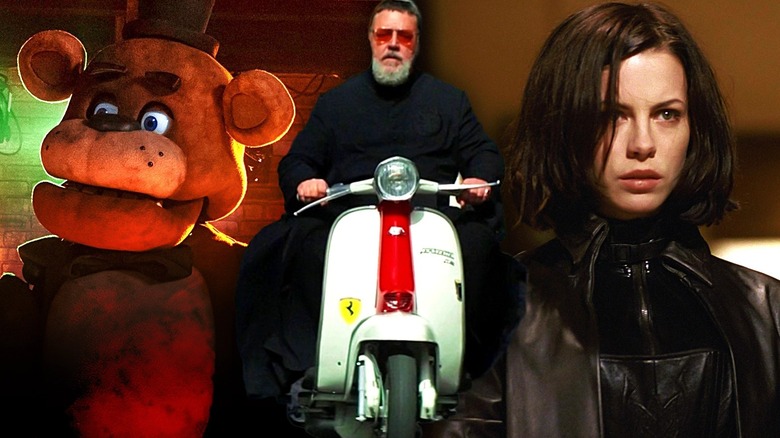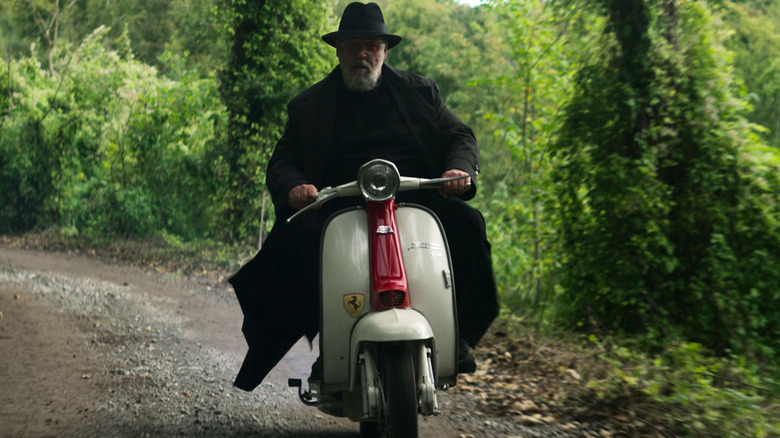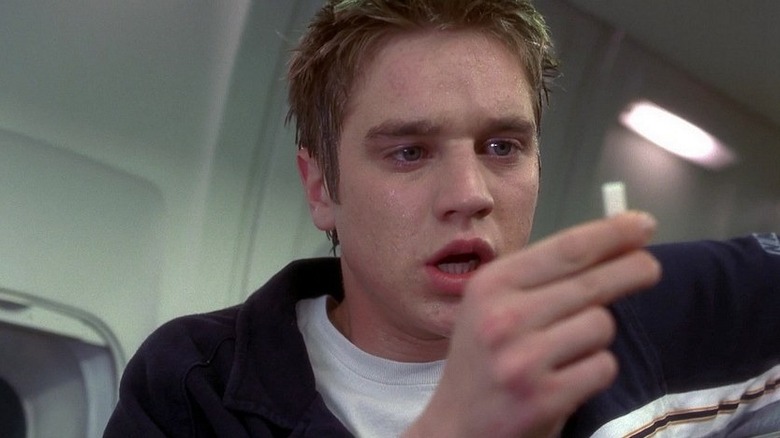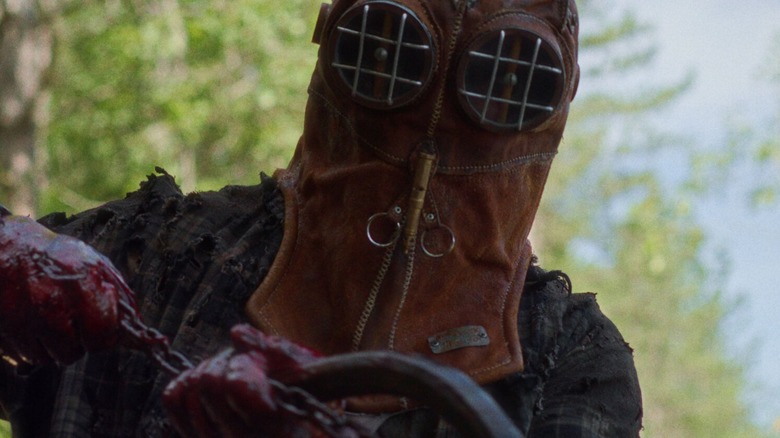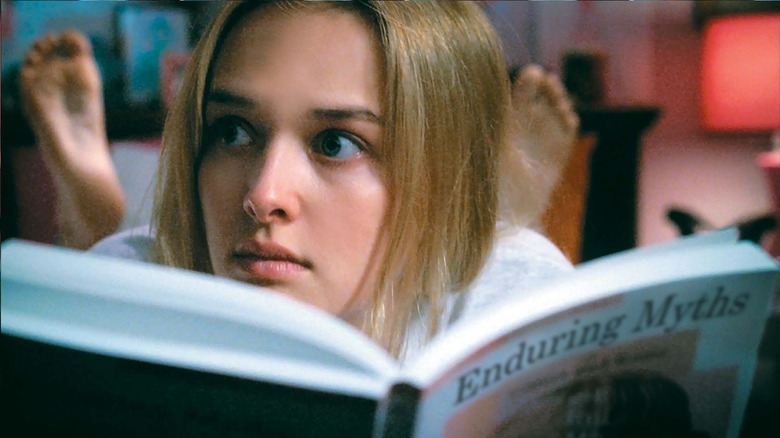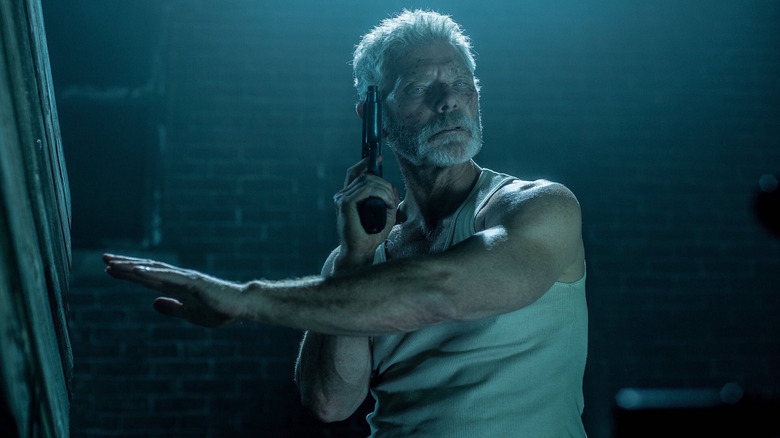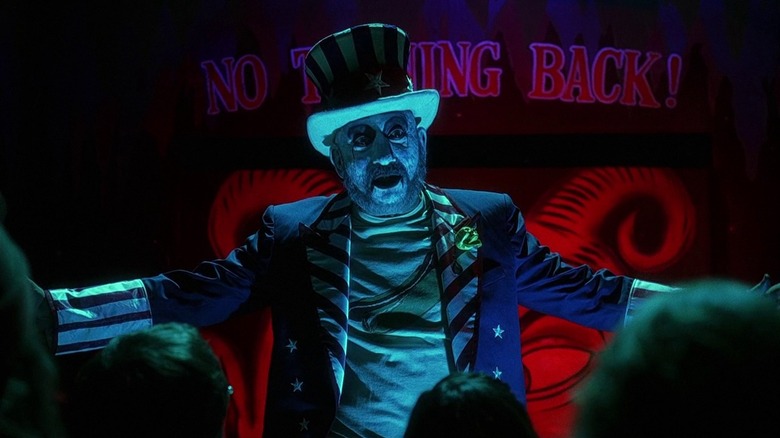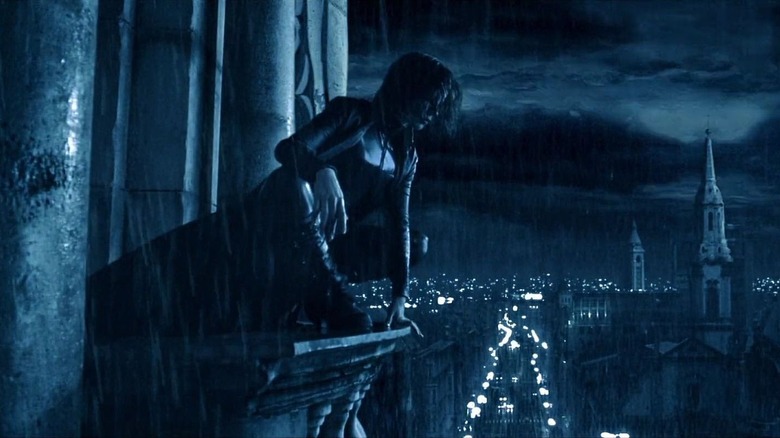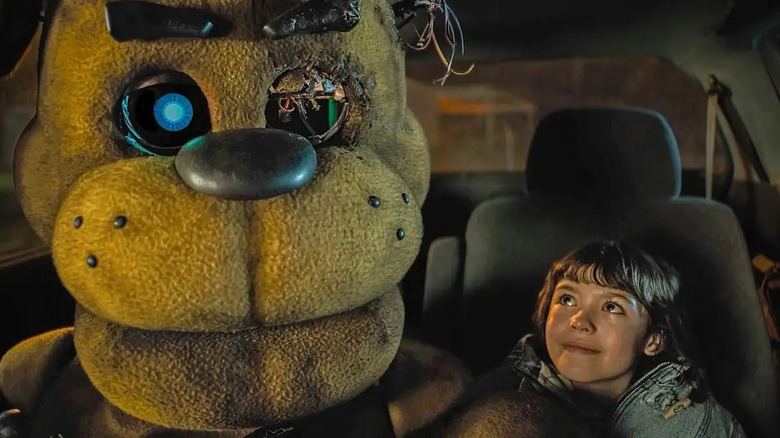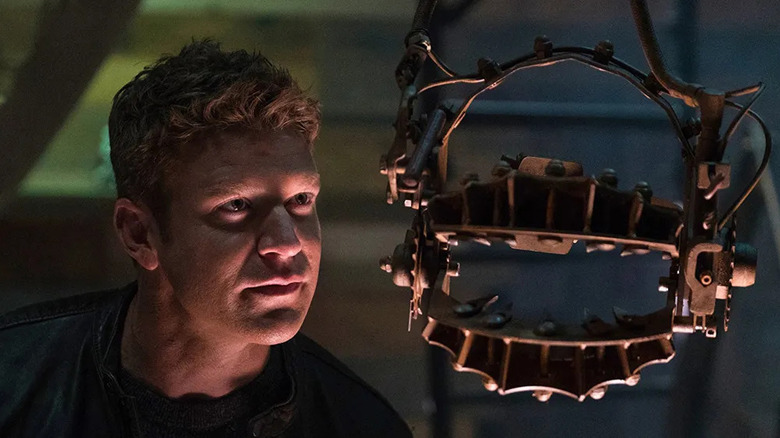Why These Horror Movies Had Huge Gaps Between Critics & Audiences On Rotten Tomatoes
For most people, horror is an acquired taste. The genre explores the darkest, most disturbing parts of ourselves and our psyches, making for stories that can range from grotesque and gory to just downright disturbing. For critics, that may not necessarily be what they look for in a movie, but for horror fans, it is the precise reason they adore the genre. As such, in the ongoing (and endlessly tiresome) culture war between critics and audiences, horror tends to be more divisive than not. Despite the site's questionable operations and easily-manipulated review system, Rotten Tomatoes continues to be the battleground in which this war is waged.
Each case is different: Some films have ardent fandoms behind them, others garner cult followings over time, and some premiere to critical fanfare but simply do not age with audiences. Whatever the case may be, these 12 horror films feature significant enough gaps in their Tomatometer score that they demand deeper investigation, especially in the wake of the recently-added "Verified Hot" badge, reserved for films with a 90% Popcornmeter rating or higher.
From cinema institutions to recent releases, these 12 horror films have big gaps between critics and audiences on Rotten Tomatoes, and we'll explain why.
The Blair Witch Project (29% difference)
Back in 1999, "The Blair Witch Project" had taken the world by storm. Thanks to a viral marketing campaign that promoted the film's story as being based on actual folklore, the film's then-novel found footage style presented the story as a true-blue documentary. Though they weren't quite as gullible, some critics were quick to deem Daniel Myrick and Eduardo Sánchez's experiment a major accomplishment, granting it a Certified Fresh rating of 86%. David Keyes of Cinemaphile called it "a redefining moment in the horror genre," while Jonathan Foreman of New York Post deemed it "the creepiest and most original horror film since ... 'Halloween.'" High praise!
The film's reputation has long preceded itself since then, but in a world where the "Paranormal Activity" and "V/H/S" franchises have turned found footage into a trope, the "Blair Witch" audience score has aged less than kindly at 57%. "Was this supposed to be scary in 1999?" asks user Nicholas S. "Maybe it was for a different time." It certainly was, but the film's wild shaky cam, slow-burn tension, and ambiguous ending were bound to not be everyone's cup of tea, both then and now. "You never actually see anything and nothing is really explained," says user Edvin H. "I get its [sic] trying to be mysterious but in reality it just doesnt [sic] say anything."
The Pope's Exorcist (30% difference)
At first glance, this Russell Crowe-led religious thriller was just another run-of-the-mill studio horror thriller designed for Hollywood's long-held obsession with exorcism. Most critics fell into place, summoning a 50% on the Tomatometer. However, its relatively high rotten score may give you a glimpse into its secret weapon. "'The Pope's Exorcist' is worth seeing for Crowe and Crowe alone," says /Film's own Chris Evangelista. "Without Crowe getting to deliver lines like 'A demon once tried to put a crucifix through my eyeball,' with a twinkle in his eye, this movie would be DOA," John Serba of Decider explained.
Underneath our noses, "The Pope's Exorcise" became one of 2023's most unexpected horror hits, particularly thanks to Crowe's witty yet committed performance. "Who can't get into a comical priest played by Russell Crowe?" jokes Damon Stinnett. "Russell on his Vespa is unusually cute," writes Tomoka M in their four-star review. Crowe's star power not only elevates the material but feels lock step with a sillier version of the film that some fans clicked with. "If this movie were to be a comedy movie, this would be a masterpiece," says Marco B in a five-star review.
Sure, not everyone was in line with the film's cheese, but even those not on the camp bandwagon enjoyed the film's pervasive atmosphere and visual effects, not to mention its unique source material in the books of Father Gabriele Amorth.
Final Destination (31% difference)
The "Final Destination" franchise has a fervent fanbase, but overall, the series has a decaying reputation. Every entry has both rotten critics and audience scores excluding the first, which sits at a humble 68% audience score and 37% critics score. Even from the beginning, critics were only mildly impressed with the film's original premise, believing that it buckles under its own weight. "The main problem is that [writer James] Morgan and [director James] Wong don't seem to have a clear idea of what they want — campy, schlocky slasher flick or moody, intelligent thriller," claims Phoebe Flowers of the Miami Herald (via Rotten Tomatoes), "and as a result they create neither."
"18 years have gone by [and] the effect the movie has [on me] has kind of diminished," admits an unnamed user in their three-and-a-half star review. "Yes the movie is cheesy ... but back in 2000, this was such an original movie and a spawned a new dawn in horror." Indeed, the film's choice to make Death the ultimate slasher villain was an impressive conceit, not to mention the gnarly kills that came with it, "far and away the strength of [the film]" according to another unnamed user. However, its soapy teen drama held it back. "A handful of its scenes are unintentionally amusing instead of scary," writes user You don't n, "[but] it's hard to fault a movie that walked so its sequels could run."
I'm Thinking of Ending Things (32% difference)
Is "I'm Thinking of Ending Things" a horror film? The question has been up for debate, but Rotten Tomatoes has it listed under "horror." So, for the purposes of this article, it counts! In fact, it might be central to the film's 32% gap in its critics and audiences score (82% and 50% respectively). After all, Charlie Kaufman's film is most visibly horror for those who are prepared to, in the words of /Film, "gaze through the glass and wonder what's going on underneath," which feels right for critics. "It is beautiful, delirious, frustrating and so wedded to that film-critic notion of the unimpeachable 'Kaufman-esque' sensibility that there is little point in arguing with its power," wrote Barry Hertz of Canada's Globe and Mail.
"This isn't a classic horror," scoffs user Ben H. "This is a movie where you sip wine and tell others that you like a nice challenging intellectual art piece." Kaufman's take on horror is so abstracted by disparate ideas, intellectual references, and slow burning tension that casual audiences were left wondering what they just watched. "I kept waiting for pieces in the movie to connect," recalled user Pam C. "They never do ... Don't waste your time." Nathan E, in a two-and-a-half star review, sums it up best. "Ive [sic] seen this film about 3 times and i [sic] swear it makes less sense."
In a Violent Nature (34% difference)
"'In a Violent Nature' is going to be divisive," declared Joshua Ryan for FandomWire, and boy, was he right. When it premiered at Sundance in early 2024, critics were quick to stir up intrigue over Chris Nash's directorial debut, with as described by Meagan Navarro of Bloody Disgusting calling it "a fascinating arthouse horror experiment that plays more like a minimalist slice-of-life feature." The film takes a "Friday the 13th"-esque slasher framework but tells the story from the killer's point of view, complete with long takes of him simply walking through the forest looking for victims. "The inventive and gory kills are worth the wait," assures our own /Film critic BJ Colangelo, "[but] the deliberately slow pacing is admittedly a real test of patience."
As it turns out, an audience's patience is thin. "The life of a movie monster in between kills is surprisingly boring," supposes user Jason B, whose three star review is pretty generous compared to most. The film saw a 78% from critics but a 44% from audiences by its wide release, suggesting most folks simply didn't care for the film's inverted commentary on the monotony of the genre. "Chocked [sic] full of unique gore and not much else," states Jeffrey P. "The novelty of it being from the p.o.v. of the killer is lost as it just makes things seem aimless and confused."
Teeth (36% difference)
Another Sundance darling turned audience puzzler, "Teeth" made a big splash when it premiered in 2007 to surprise raves. The film, directed by Mitchell Lichtenstein, was hailed as "a fun exploration of feminine sexual power seen through the twisted kaleidoscope lens of a horror-comedy" by Cinematical critic Kim Voynar and deemed "campy, shameless and sophisticated" by Los Angeles Times' Carina Chocano. The film's audacious genre blend and wicked sense of humor was so provocative that it cemented a reputation as the movie to watch.
Upon wider release, the film garnered a new reputation as some bizarre "so-bad-it's-good" schlockfest. Today, the film sits at a disparate 81% with critics and 45% with audiences. "A movie you hate to love!" says one unnamed user. Another mystery user simply responded with "watinthebluefuqdidijustwatch.jpeg." To say audiences were befuddled by it is an understatement, but most folks simply see "Teeth" as a cheesy, poorly acted horror film that didn't take its concept far enough. "The story is somewhat original but far too simplistic in conception and structure," writes yet another unnamed user. "The movie has one gag," referring to the film's genital chompers, "[and] as the movie unfolds, this gag quickly becomes much more repetitive and tedious than horrific or funny." Perhaps with an even stronger b-movie sensibility, audiences would've been more in on the joke.
Tarot (39% difference)
It's rare that a horror film has such a wide gap between two still-rotten scores, but that's what happens when Hollywood tries turning playing cards into IP. With its 56% audience score, it's clear most people would not go to bat for "Tarot," but a 17% critics score turned an otherwise forgettable piece of studio slop into one of the year's most derided films. "'Tarot' is at once a disciple of The Tower," wrote Charlotte Smmons of We Got This Covered, referring to the tarot card, "apathetic, disgraceful, ruinous, and an utter, mirthless catastrophe." "This would've been a 'straight-to-DVD' [movie] back in the day," says Jorde Rivera Rubio of QiiBO (translated from the original Spanish).
That said, many critics were apt to point out the film's creative creature designs and clever kills, something that younger audiences saw as enough to spread positive word-of-mouth and make "Tarot" 2024's sneakiest horror box office hit. "Though it certainly has room for improvement," admits one unnamed user, "it feels like the focus was more on the creative ways each character interacts with their tarot cards, which was an interesting and unique approach." Spencer S agrees, writing that the "monsters of the tarot deck are easily the best part, all designed by the magnificent artist Trevor Henderson in delectable fashion." Few audience reviews go so far as to name drop a concept artist, so that has to count for something!
Don't Breathe 2 (42% difference)
The first "Don't Breathe" was a blissfully original horror bender that felt like lightning in a bottle, which, historically, is difficult to capture twice. Case in point: where the first film's Rotten Tomatoes gap was a measly 9%, "Don't Breathe 2" landed at a whopping 42%. What happened? Well, it might have something to do with the choice to focus the story on the previous film's blind villain, portrayed by Stephen Lang. "Lang remains a hulking, physically dominant actor," writes Nate Adams for The Only Critic, "but his performance can't address the elephant in the room: Why in the world am I rooting for a rapist and murderer?"
While the film wasn't able to sell a redemption arc to critics, fans felt the film's approach added new dimensions to the story. "This film does such a wonderful job in muddying the waters regarding who the antagonist and protagonists are," explains user Beverly D. "You spend as much time wondering who you should root for as you do marveling at the masterful way suspense is building." For most fans, the sequel maintained the original's stylistic brutality, which was enough to make it "an enthralling home invasion/revenge thriller," in the words of one unnamed user, one that "dishes out plenty of creative set pieces and gory fun."
If you or anyone you know has been a victim of sexual assault, help is available. Visit the Rape, Abuse & Incest National Network website or contact RAINN's National Helpline at 1-800-656-HOPE (4673).
House of 1000 Corpses (44% difference)
This one is for the true horror nuts out there. We don't think any fan of "House of 1000 Corpses," Rob Zombie's ultraviolent directorial debut, would be surprised to learn that critics weren't in love with the film. Its roots in the raunchy exploitation films of the 1970s are all but dialed up to 11, making for a gory good time that loses the subtext of its inspirations. Jamie Russell of the BBC called it "a tour-de-farce of depressing inanity, that's unable to do anything more than offer a messy, incoherent pastiche of other, better movies."
Unsurprisingly, the film has since become a cult hit, sitting at a 21% critics score and a 65% audience score. "This movie is a masterpiece, and I don't want to hear anybody saying otherwise," raves user One-Eyed Myra. Meanwhile, Bob A incredulously deems it "a comfort film ... one of my all time favorites!!!" "Of course it aint [sic] the big thing," assures one unnamed user, "but its [sic] a horror movie made for slasher and grindhouse films enthusiasts," which is exactly right. For folks who love Zombie's genre sensibilities, it is the ultimate celebration of them.
The film's harshest critic might be Zombie himself. "[The film] is just a calamitous mess," he told 3news in 2014. "When it came out ... everyone hated it. Now everyone acts like it's beloved in some way. All I see is flaw, upon flaw."
Underworld (48% difference)
Here's another storied horror franchise for which folks seem to have a soft spot. The "Underworld" series has long been fodder for critics, as not one entry in the franchise sports a Fresh rating on the Tomatometer. It all began with the critics lambasting the first installment with a 37% score, citing a serious case of style over substance. "Wiseman, who has an extensive background in art direction, has art directed this film to death," wrote Kevin Courrier of Boxoffice Magazine. "'Underworld' is one of the most visually stunning motion pictures of the year," admits Dustin Putman of TheFilmFile.com. "Everything else ... is ready for the scriptwriter's junkyard."
For fans, however, the style is the substance, granting the film a 79% on the audience's Popcornmeter. "Stylish art direction, Kate Beckinsale's performance, compelling mythology, a well-done mixture of animatronics, make-up and CGI ... and [a] darker, more serious tone than your average vampire film make this fantasy-action-horror flick stand out amongst other films in the vampire and 'Matrix knockoff' subgenres," wrote one unnamed user. "The movie is a well crafted love letter to anyone who played 'Vampire: The Masquerade' or routinely went to Goth Clubs to dance to Sisters of Mercy," according to Richard F, whose niche references alone confirm it as "an absolutely fantastic movie for any fan of the Vampire genre."
Five Nights at Freddy's (54% difference)
Gamer fandom is one helluva drug. Despite being delayed several times and cycling through multiple directors, the fans embraced the long-gestating "Five Nights at Freddy's" film, awarding it an 86% audience score. User Andrew B decidedly deemed it "one of the best video game adaptations ever made" and "an absolute must see for fans of the game and other gamers." Many other fans, including Joey G, were also quick to especially point out that "the animatronics, created by the geniuses at The Jim Henson Creature Shop are absolutely incredible." In a sense, "Five Nights" helped convince gamers that the video game movie curse had been lifted, alongside other popular adaptations such as "Uncharted" and "The Last of Us."
Critics, however, were less than kind, landing at a 32% score on the Tomatometer. Despite the game's iconic balance of cheery imagery with disturbing intensity, the film never manages to achieve the same, resulting in a film that wants to be in on its own jokes but never quite makes it there. "You may chuckle," warns Natalia Winkelman of The New York Times, "but it's hard to tell if the movie is laughing with you." "Lost at the crossroads of inadvertent comedy and horror," concurs Mark Kennedy of The Associated Press, "'Five Nights at Freddy's' has to go down as one of the poorest films in any genre this year."
Jigsaw (56% difference)
The "Saw" franchise is very familiar with gaps in taste between critics and audiences on Rotten Tomatoes. Some of the largest include "Saw V" with a 39% gap, "Saw II" and "Saw III" with 42% gaps, and "Saw IV" with a 44% gap. However, it is the franchise's first soft reboot, "Jigsaw," that reigns supreme with an absurd 56% gap, making it one of the largest across the entire Rotten Tomatoes platform.
Unsurprisingly, the critics are the rotten side of the gap at 32%, as they simply couldn't be bothered with yet another torturous entry in the long-running series, even after a seven-year break. "'Jigsaw' is simply the same old stuff, writes Brian Orndorf of Blu-ray.com, "only more deflated and desperate, missing visual oomph, ghoulish imagination, and a reason to be." "Fans of the 'Saw' franchise should see this movie," clarifies Brad Gullickson of Film School Rejects. "Everyone else, not so much."
Welp, that's exactly who saw the movie and gave it an 88% Popcornmeter score. "Is this the best Saw movie? Nope," admits user Josh A, but "it felt like a transition into a new era. The era of Jigsaw copycats." This, of course, leads to the next "Saw" entry, "Spiral," which...also has a considerable score gap at 37%. At least "Saw X" managed two Fresh scores! Surely Saw XI is coming, right? ...right?
